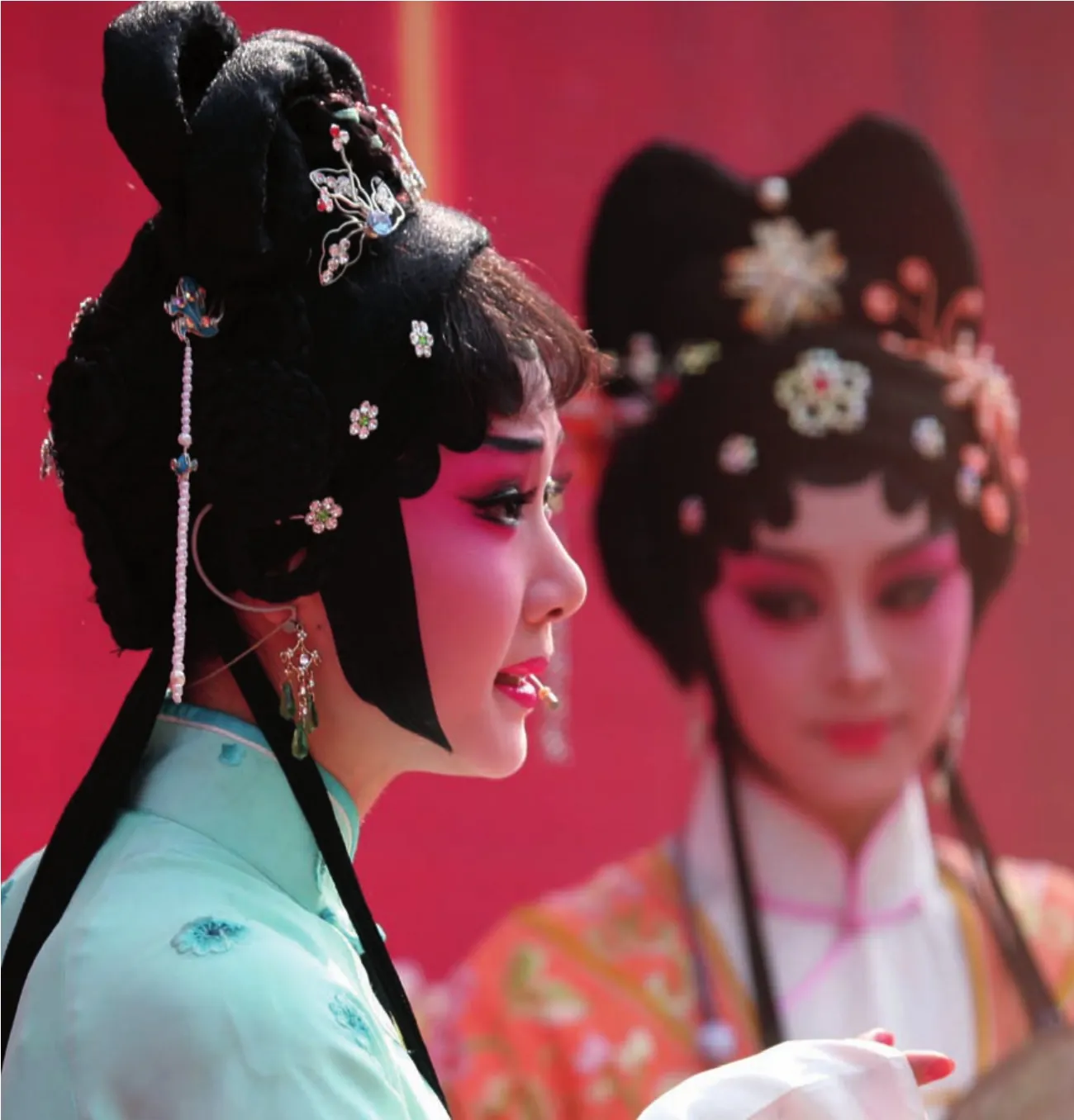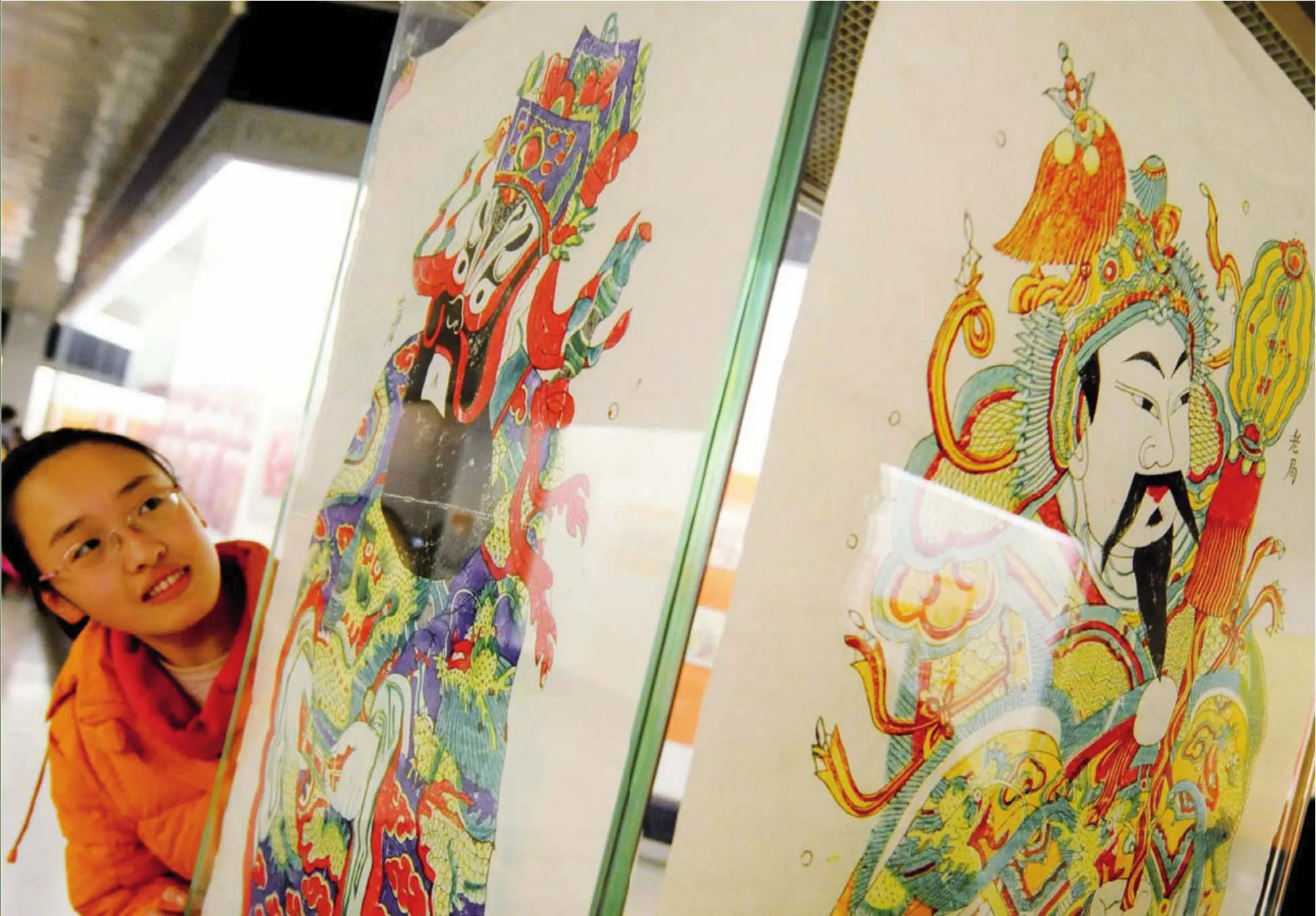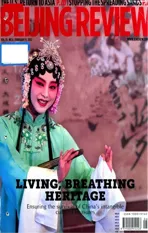SPRING STEPS
2012-10-16ResurgenttraditionalcultureaddscolortoChineseNewYearfestivitiesByYuYan
Resurgent traditional culture adds color to Chinese New Year festivities By Yu Yan
COVER STORY
SPRING STEPS
Resurgent traditional culture adds color to Chinese New Year festivities By Yu Yan
At the tail of the Chinese Lunar New Year, the whole country is still immersed in gaiety. The joyous atmosphere lingers in the red lanterns along the streets, in the colorful candy wrappers, and in the brilliant folk art performances.
For many Chinese people, old or young,to watch dragon dances, paper cutting, shadow puppetry shows and local dramas is the best part of the festival. All good wishes for a new year burst out at those moments.
Indeed, the various folk art performances have been an indispensable part of this traditional festival since ancient times. As one of the world’s oldest continuous civilizations,China has a wealth of intangible cultural heritage. As precious cultural genes of the Chinese nation, some folk arts have been listed as world cultural heritage by UNESCO.In the past two decades, the country has made enormous efforts to identify, recognize and protect such treasures. Shadow puppetry andKunquopera are two prominent examples.
Shadow puppetry
The ancient performing art of shadow puppetry regained center stage after a long period of neglect, after it was newly added to UNESCO’s World Intangible Cultural Heritage List on November 27, 2011.
Shadow puppetry is one of China’s earliest performance arts. It appeared in the Han Dynasty (202 B.C.-A.D. 220) and became very popular in many parts of the country during the Tang Dynasty (618-907) and Song Dynasty (960-1279).
Shadow puppetry is a combination of performing arts and the carving art. The puppeteers operate the puppets behind a back-lit curtain screen. The audience sees the action unfold as the shadows play across the screen.The puppets, which are made of ox, sheep, or donkey skin, are essential stage props as well as brilliant handcrafted artworks. They present not only the characters, but also all kinds of objects from everyday life, such as clothes,ornaments, towers, pavilions, furnishings, and scenery.
The faces of the shadow figures, including human, supernatural, and animal beings,are carved intricately. Their facial features are often exaggerated. The young heroes and heroines, for example, often have elegant and noble slanted foreheads and noses.Treacherous characters always have extremely large eyes.
The origin of shadow puppet dates back over 2,000 years. It is said that a favorite concubine of Emperor Wu in the Han Dynasty died of an illness. The emperor missed her so much that he lost enthusiasm for life. One day, a minister happened to see children playing with dolls. When they played, the shadows on the fl oor moved vividly. Inspired by this scene, the smart minister got an idea.He made a cotton puppet of the concubine and painted it.
At night, he invited the emperor to watch a performance. The emperor was very happy to see the lively puppet of the concubine.
However, in modern times, amid the surge of fi lm and television, people gradually lost interest in puppet shows, and the art form faced extinction.

CFP
“We should preserve the tradition of our shadow puppetry. We should preserve not only the puppets and props but also the theater texts and music. They are part of Chinese culture. They may help promote Chinese culture and contribute to the creation of new art forms,” said Sun Jianjun, a professor at the Academy of Arts and Design at Tsinghua University.
Liu Nianhua, a 57-year-old puppeteer in Qianjiang, central China’s Hubei Province,felt the urgency of passing on this ancient art.“I was worried this precious art maybe lost to the world,” said Liu.
Currently, there are no more than eight puppeteers in Qianjiang, he said.
But the inclusion of shadow puppetry on the UNESCO list could provide a vital lifeline to the dying art form. Since then, a flood of visitors have rushed to Haining, east China’s Zhejiang Province, to appreciate puppetry shows.
Haining, an important center of shadow puppetry, has attached great importance to shadow puppetry protection. It has carried out a project to protect several classic shows through sound and video recording. Also, the city passed a fi ve-year plan on the protection work.
So far, it has sorted out documentaries totaling 280,000 words, rehearsed 37 plays, and recorded more than 60 performances. And it has collected more than 1,000 stage props.
Xu Ernan, an old shadow puppeteer from Haining, said he is con fi dent for the future.

PU XIANGDONG
“I felt full of energy when it occurred to me that my efforts could enable shadow puppetry to be passed on,” said Xu.
Kunqu Opera
While shadow puppetry is the latest Chinese item to make the UNESCO list,KunquOpera was the first to be inscribed onto it in 2001.Efforts to invigorate this ancient art have already been rewarded.
“As a living performing art,KunquOpera should be constantly developed with the changes in real life,” said Dong Wei, Director of the Arts Department of the Ministry of Culture, at a meeting to celebrate the 10th anniversary ofKunquOpera’s listing in Beijing in 2011.
With a history of over 600 years,KunquOpera is known as the mother of all operas in China. The opera sounds hauntingly graceful. It features good control of the voice and rhythm. When performed, the opera is accompanied by various kinds of traditional Chinese musical instruments. However, this ancient performing art was on the verge of extinction before 2001.
“Years ago, when I was asked by taxi drivers about my job, I felt ashamed to tell him I was aKunquactor,” said Ke Jun, head of Jiangsu ProvincialKunquOpera Theater.
“Once, when I performed, there were more than 20 performers on stage, while only three in the audience below. Of the three, one was sleeping, one was walking around and the other was cracking and eating melon seeds,”said Ke.
Fortunately, this situation has changed since the opera was recognized by UNESCO in 2001. So far, it has gradually regained dignity and its rightful status in modern society.
“When you find a fabulous thing, you will fall in love with it. When you love it, you will be devoted to it.KunquOpera is an art with unique charm. We are determined to be devoted to it and pass it on,” said Ke.
In Kunshan, Jiangsu Province, the cradle ofKunquOpera, a museum was built in 1993 to promote this traditional art.
But the opera is not just a museum piece.It has been regaining popularity. For instance,the most popular playPeony Pavilion, which was based on its namesake ancient romance by Tang Xianzu in the Ming Dynasty (1368-1644), is now staged in theaters, on campuses and at clubs, both at home and abroad.
This owes to the ceaseless efforts ofKunquOpera lovers such as Ke. In recent years, Ke has devoted himself to breaking the mold and bringing many modern elements into classical plays.
Ke strived to make the opera in tune with the pulse of modern society. During the World Expo in Shanghai in 2010, the Jiangsu ProvincialKunquOpera Theater cooperated with a Noh theater from Japan. The two created a multi-mediaKunquplay on environmental protection. In total, the 20-minute play was performed more than 6,000 times during the expo, attracting large international audiences.
What’s more, Ke also cooperated with a lot of big private companies as a means of attracting more social forces into the promotion of the opera. He visited South Korea, Sweden,Japan, India and other countries to introduce the opera, gaining international fame.
“I believe as long as I stick to it,KunquOpera can embrace a better future one day,”said Ke.
Passing the craft on
In addition to Shadow puppetry andKunquOpera, UNESCO has in total recognized 27 more items of living heritage in China by now. But they are only a small part of China’s rich human treasures ranging from song, music, drama, skills to crafts.

ZHU XIANG

ZHANG WENKUI
(Left) DREAM-LIKE CHARM: Zhu Bingzhen, heroine of theKunquOpera playDream of Red Mansions, performs at the play's press release in Beijing on August 8, 2011
ALL ABOUT DETAILS: A middle school student appreciates Chinese traditional New Year’s painting works at an exhibition in Zhengzhou, Henan Province, on January 15, 2012
(Above) RED BLESSING: A paper cutting work on the Chinese totem of dragon is displayed at a Spring Festival folk culture fair in Shenyang, Liaoning Province on January 25, 2012
To better preserve and pass on these treasures, China introduced a national project in 2005 to recognize and fund representative inheritors of folk crafts to pass them down from generation to generation.
Chen Xingcai, 93, is one of them. As one of the inheritors of Mianzhu New Year’s painting craft, he has already passed the craft to his grandson, Chen Gang, and Chen Gang is teaching his five-year-old son to paint already.
Mianzhu in southwest China’s Sichuan Province is one of the four famous manufacturers of New Year’s paintings in China,along with Yangliuqing in Tianjin, Taohuawu in Suzhou, Jiangsu Province and Weifang in Shandong Province. It features bright colors and intricate hand painting, a style dating back to the Song Dynasty, which thrived in the Qing Dynasty (1644-1911) but fell to the wayside in recent decades. Young people have been reluctant to learn the skills required to master the handicraft. But the reconstruction after the 2008 Earthquake in Sichuan has saved the art form, which is protected as an intangible cultural heritage, from the brink of extinction.
Under a partnership plan which encourages cities nationwide to mobilize capital and labor to support the reconstruction in Sichuan, Suzhou spent more than 30 million yuan ($4.62 million) establishing a New Year’s painting base in Nianhua Village.Now more than 90 percent of the villagers make a living on making New Year’s paintings, as well as related businesses in the process. Jiangsu has also helped with sales of the paintings.
The Chen family is living in a government-funded quadrangle courtyard now,making an income of more than 100,000 yuan($15,400) annually from the business.
Chen Yunlu, uncle of Chen Gang, started to learn the craft at the age of 10 and is now instructing young painters at the local museum.
“We can only keep such a traditional craft alive by infusing new content into it,” Chen Yunlu toldBeijing Review. “Although we are working around the clock to meet the orders,we think innovation either in content or form will secure us better market prospects.”
The younger generation is able to take advantage of e-commerce. “We sell about 10,000 paintings every year, of which 10 percent are for online orders and this percentage is still increasing,” said Chen Gang.
Legislation efforts
In addition to the inheritor system, the Chinese Government has also made efforts to protect the nation’s cultural heritage through legislation.
After a decade’s drafting, China’s first law for intangible cultural heritage came into force on June 1, 2011. The legislation is expected to ensure better preservation of the country’s cultural legacy.
“The primary target of China’s heritage protection efforts used to be tangible items including artifacts and historic relics. The enactment of this new law means that for the fi rst time Chinese traditional cultural practices now have legal protection,” said Zhu Bing, an of fi cial from the Standing Committee of National People’s Congress, China’s top legislature.
The law is responsible for the traditional cultural expressions and practices of China’s various ethnic groups, which have been handed down through generations.
It speci fi cally covers traditional oral literature, performing arts, craftsmanship, medicine and folk customs.
